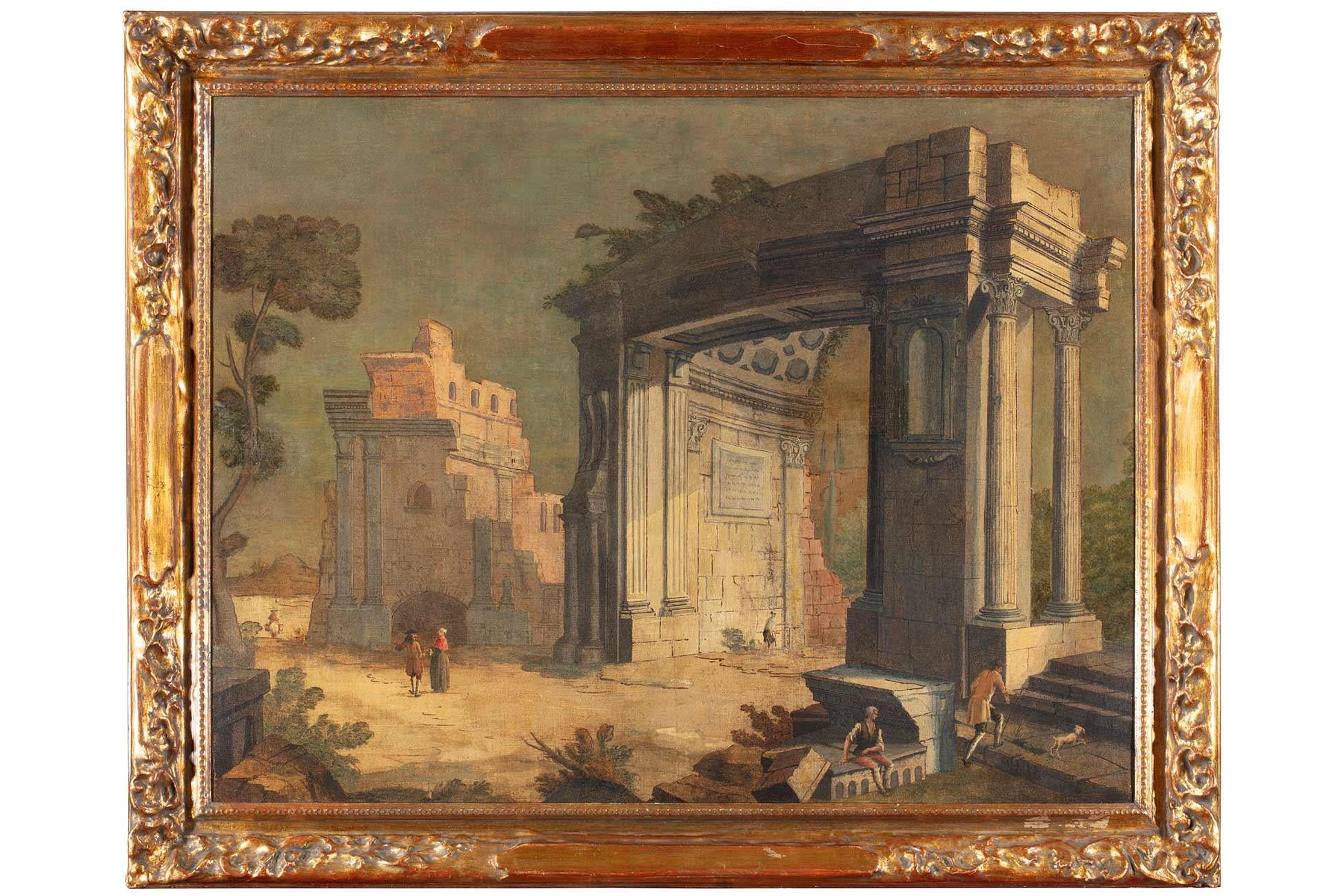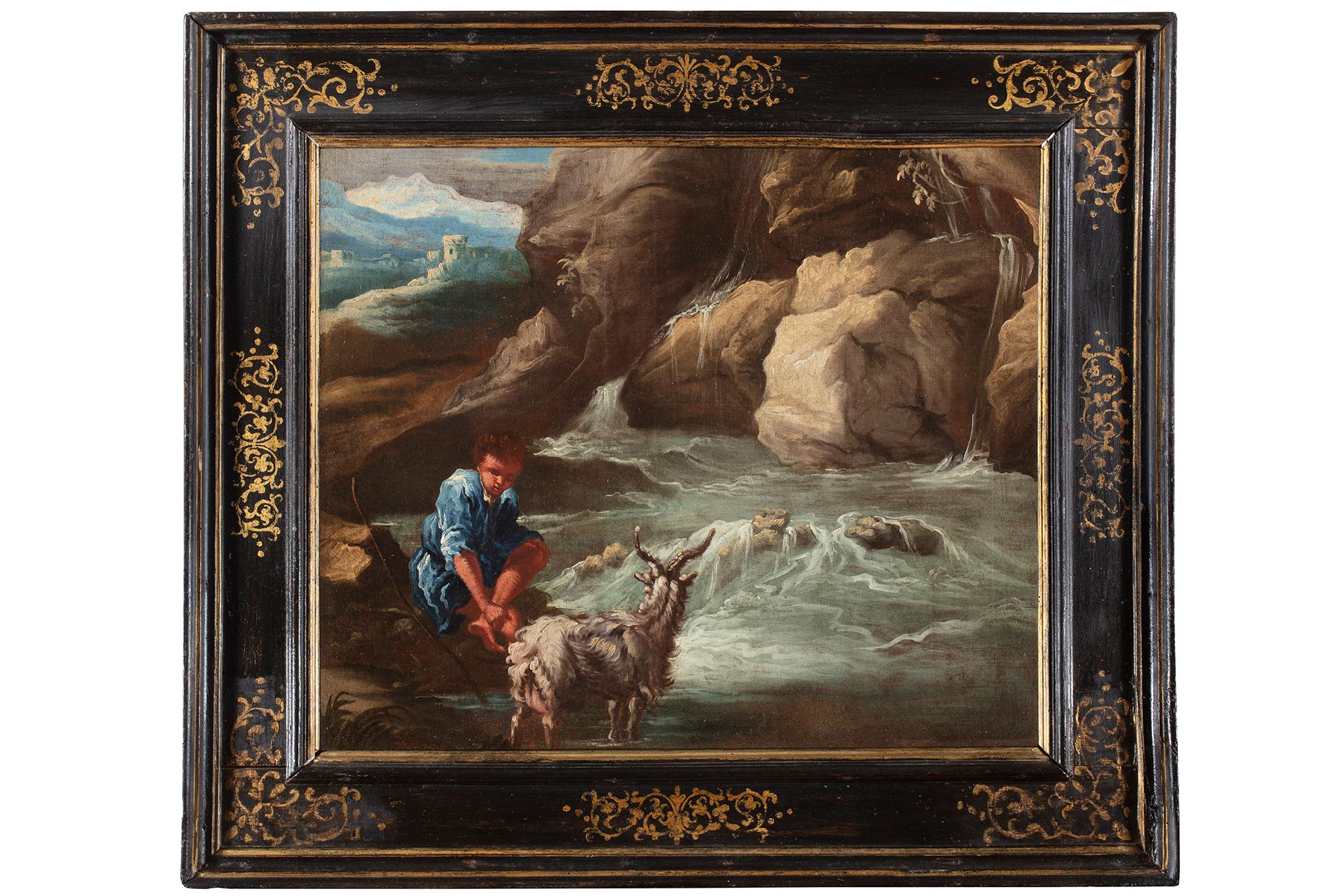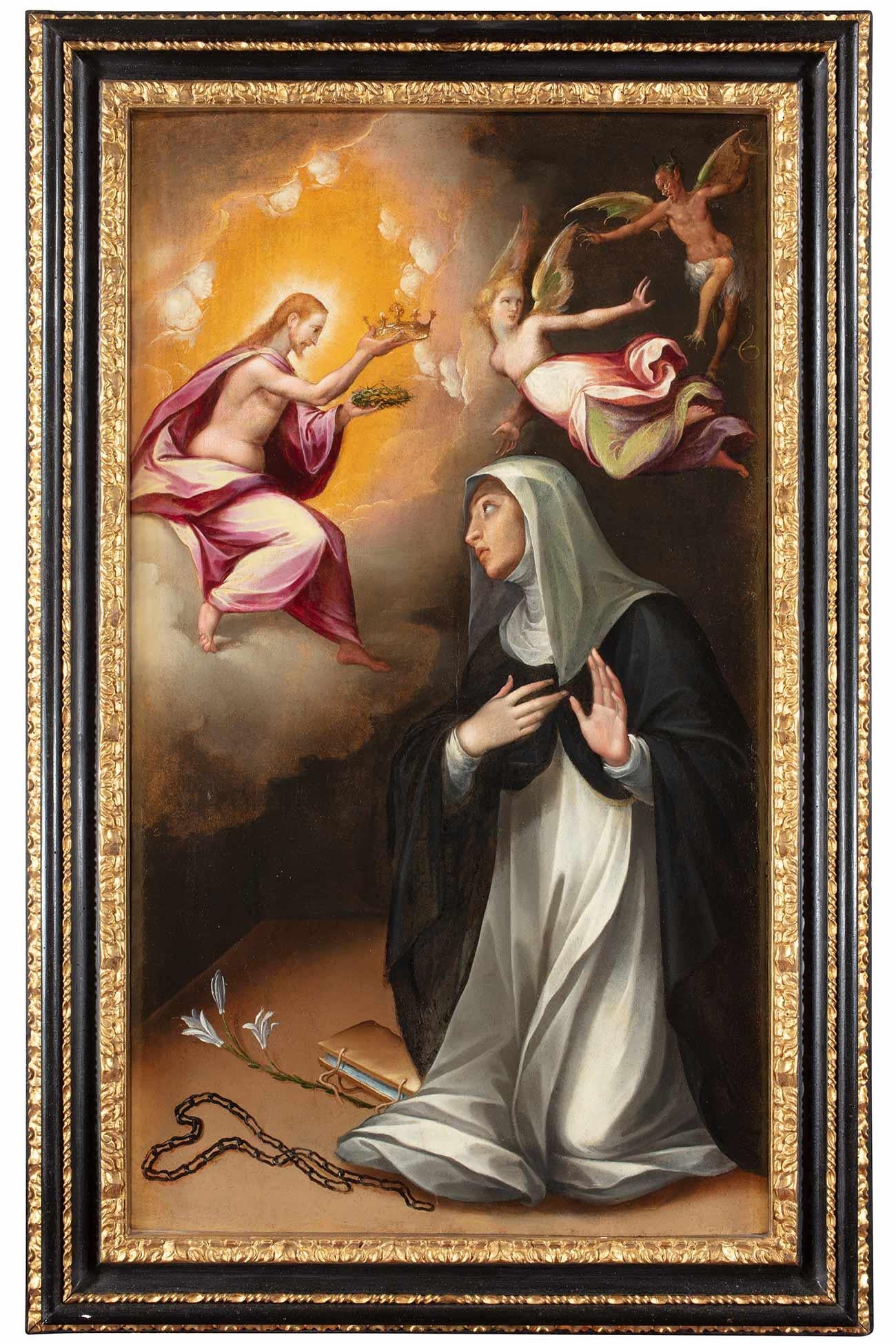Items Similar to A pair of 18th century Italian landscapes with classical ruins and figures
Want more images or videos?
Request additional images or videos from the seller
1 of 8
A pair of 18th century Italian landscapes with classical ruins and figures
About the Item
A pair of 18th century Italian landscapes with classical ruins and figures, circa 1750.
Circle of Giovanni Panini (1691-1765)
Thomas Agnew and Sons, London, labels on the reverse
Each oil on canvas, 60 x 103cm (23 x 40in), in period giltwood frames
Provenance:
A F Marreco, Weidenfeld & Nicolson, 2 Cork Street, London
Sold by Thomas Agnew and Sons, Bond Street, London in 1957 as 'Panini'.
Giovanni Paolo, also known as Gian Paolo Panini or Pannini (17 June 1691 – 21 October 1765), was an Italian painter and architect who worked in Rome and is primarily known as one of the ‘vedutisti’ (view painters). As a painter, Panini is best known for his vistas of Rome, in which he took a particular interest in the city’s antiquities. Among his most famous works are his view of the interior of the Pantheon and his vedute—paintings of picture galleries containing views of Rome. Most of his works, especially those of ruins, have a fantasy element of embellishment, characteristic of capriccio themes where the artist draws on his imagination to group together decorative ruins, unlikely to be found in such close proximity in reality.
These paintings were very popular ‘Grand Tour’ souvenirs for wealthy tourists in the 18th century, allowing them to capture many of their favourite architectural sites combined into an impressive painting which they could take home and prominently display in their grand country homes.
.
- Dimensions:Height: 23.63 in (60 cm)Width: 40.56 in (103 cm)
- Medium:
- Movement & Style:
- Circle Of:Giovanni Paolo Panini (1691 - 1765)
- Period:
- Condition:
- Gallery Location:Bath, GB
- Reference Number:1stDibs: LU95214004762
About the Seller
5.0
Vetted Seller
These experienced sellers undergo a comprehensive evaluation by our team of in-house experts.
Established in 2002
1stDibs seller since 2015
36 sales on 1stDibs
Typical response time: 1 hour
Associations
The British Antique Dealers' AssociationLAPADA - The Association of Arts & Antiques DealersInternational Confederation of Art and Antique Dealers' Associations
- ShippingRetrieving quote...Ships From: Bath, United Kingdom
- Return PolicyA return for this item may be initiated within 3 days of delivery.
More From This SellerView All
- Attributed to John Riley, 17th century English portrait of a girl on a terraceBy John RileyLocated in Bath, SomersetPortrait of a young girl, full-length, wearing a blue silk gown, standing on a terrace beside a classical urn holding a branch with blossom. Attributed to John Riley...Category
17th Century Old Masters Portrait Paintings
MaterialsOil, Canvas
- A large English 18th century painting of a Chestnut horseBy Thomas BeachLocated in Bath, SomersetA saddled chestnut hunter tethered to a post at the entrance to stables with a wooded landscape and a hill beyond. Signed and dated lower left, 'T. Beach pt., 1785'. Provenance: Anonymous sale, London, Christie's 28 May 1999. lot 15 Thomas Beach was essentially known as a portrait artist and the present painting is a rare example of his skill as an animal painter. His ability to convey a sense of the character of his sitters is evident here in the remarkably sensitive portrayal of the horse's expression. Beach painted...Category
18th Century English School Animal Paintings
MaterialsCanvas, Oil
- English early 19th century painting of a chestnut hunter in a landscapeBy John Ferneley SeniorLocated in Bath, SomersetA painting of a chestnut hunter in a landscape with a horse and rider accompanied by two hounds by a woodland river in the distance. Signed and inscribed 'Melton Mowbray', lower left. Oil on canvas in a giltwood frame. John Ferneley Sr (1782-1860) was born the son of a Leicestershire wheelwright, the youngest of six children. He is known as one of the great British equine artists, perhaps only second to Stubbs in terms of raw ability. Ferneley originally worked with his father, until by chance the Duke of Rutland saw some of his work on the side of a cart on which Ferneley and his father had been working. The Duke was so impressed with Ferneley that he persuaded John's father to allow him to become the pupil of Benjamin Marshall. Ferneley was so talented that apparently he produced almost perfect copies of his tutor's paintings and they were said to have been indistinguishable from the master’s. Marshall also enrolled him as a student of the Royal Academy Schools. In 1804 Ferneley paid a man named Thomas Harrison...Category
Early 19th Century English School Animal Paintings
MaterialsCanvas, Oil
- 19th century English School, Bay Horse and a Terrier in a LandscapeLocated in Bath, SomersetA bay hunter and a black and white short haired dog (possibly a bull terrier) in an extensive English landscape. a rustic barn in the near distance. Indistinctly signed 'Br...' and d...Category
Early 19th Century English School Animal Paintings
MaterialsCanvas, Oil
- English late 19th century painting of a fox with a rabbitBy George William HorlorLocated in Bath, SomersetA fox and a rabbit by a rabbit hole in woodland undergrowth, Circle of George William Horlor (1849-1895) Oil on canvas in a giltwood frame. Canvas size: 46 x 71cm In frame: 59x 83cm ...Category
Late 19th Century English School Animal Paintings
MaterialsCanvas, Oil
- An English 18th century portrait of James Stanley, standing in a landscapeBy John Hamilton MortimerLocated in Bath, SomersetPortrait of James Stanley (1750 - 1810), circa 1775-1778, full-length, wearing a red coat and breeches and a gold embroidered waistcoat, hold...Category
1770s English School Portrait Paintings
MaterialsOil, Canvas, ABS
You May Also Like
- Early oil depicting the Great Fire of LondonLocated in London, GBThe Great Fire of London in September 1666 was one of the greatest disasters in the city’s history. The City, with its wooden houses crowded together in narrow streets, was a natural fire risk, and predictions that London would burn down became a shocking reality. The fire began in a bakery in Pudding Lane, an area near the Thames teeming with warehouses and shops full of flammable materials, such as timber, oil, coal, pitch and turpentine. Inevitably the fire spread rapidly from this area into the City. Our painting depicts the impact of the fire on those who were caught in it and creates a very dramatic impression of what the fire was like. Closer inspection reveals a scene of chaos and panic with people running out of the gates. It shows Cripplegate in the north of the City, with St Giles without Cripplegate to its left, in flames (on the site of the present day Barbican). The painting probably represents the fire on the night of Tuesday 4 September, when four-fifths of the City was burning at once, including St Paul's Cathedral. Old St Paul’s can be seen to the right of the canvas, the medieval church with its thick stone walls, was considered a place of safety, but the building was covered in wooden scaffolding as it was in the midst of being restored by the then little known architect, Christopher Wren and caught fire. Our painting seems to depict a specific moment on the Tuesday night when the lead on St Paul’s caught fire and, as the diarist John Evelyn described: ‘the stones of Paul’s flew like grenades, the melting lead running down the streets in a stream and the very pavements glowing with the firey redness, so as no horse, nor man, was able to tread on them.’ Although the loss of life was minimal, some accounts record only sixteen perished, the magnitude of the property loss was shocking – some four hundred and thirty acres, about eighty per cent of the City proper was destroyed, including over thirteen thousand houses, eighty-nine churches, and fifty-two Guild Halls. Thousands were homeless and financially ruined. The Great Fire, and the subsequent fire of 1676, which destroyed over six hundred houses south of the Thames, changed the appearance of London forever. The one constructive outcome of the Great Fire was that the plague, which had devastated the population of London since 1665, diminished greatly, due to the mass death of the plague-carrying rats in the blaze. The fire was widely reported in eyewitness accounts, newspapers, letters and diaries. Samuel Pepys recorded climbing the steeple of Barking Church from which he viewed the destroyed City: ‘the saddest sight of desolation that I ever saw.’ There was an official enquiry into the causes of the fire, petitions to the King and Lord Mayor to rebuild, new legislation and building Acts. Naturally, the fire became a dramatic and extremely popular subject for painters and engravers. A group of works relatively closely related to the present picture have been traditionally ascribed to Jan Griffier...Category
17th Century Old Masters Landscape Paintings
MaterialsOil, Canvas
- 18th Century By Vincenzo Re The Pool of Bethesda Oil on CanvasLocated in Milano, LombardiaExpertise by Prof. Giancarlo Sestieri. Vincenzo Re (Parma, 1695 – Napoli?, 1762) born in Parma, was an Italian scenic designer who during his career worked as initially an assistant...Category
18th Century Old Masters Landscape Paintings
MaterialsCanvas, Oil
- 17th Century by Simone Cantarini Adoration of The Magi Painting Oil on CanvasLocated in Milano, LombardiaSimone Cantarini (Pesaro 1612 - Verona 1648) Adoration of the Magi Oil on paper applied to canvas, cm. 16,5 x 24 – with frame cm. 22 x 29 Antique sh...Category
Early 17th Century Old Masters Figurative Paintings
MaterialsCanvas, Cotton Canvas, Oil
- 18th Century by Antonio Stom Architectural Capriccio Oil on Canvas_By Antonio StomLocated in Milano, LombardiaAntonio Stom (Venice c. 1688 - 1734) Architectural Capriccio oil on canvas, cm. 88 x 113 - with frame cm. 106 x 132 Carved, sculpted and gilded wooden frame Expertise: Giancarlo S...Category
Early 18th Century Old Masters Landscape Paintings
MaterialsCanvas, Cotton Canvas, Oil
- 18th Century by Giuseppe Pianca Shepherd with Goat and River Oil on CanvasLocated in Milano, LombardiaGiuseppe Antonio Pianca (Agnona di Borgosesia/VC, 1703 - after 1757) oil on canvas, cm. 49 x 57 - with frame cm. 67 x 77 Antique shaped wooden cassetta frame, ebony and gold decora...Category
18th Century Old Masters Landscape Paintings
MaterialsCanvas, Cotton Canvas, Oil
- 16th Century by Cristofano Roncalli Saint Catherine of Siena Oil on CanvasLocated in Milano, LombardiaCristofano Roncalli (Pomarance 1552 - Rome 1626) Saint Catherine of Siena chooses the crown of thorns oil on wood, cm. 101,5x59.5 - with frame cm. 120x76 Shaped, carved and sculpted wooden cassetta frame, partly gilded and partly ebonized wood Expertise: Marco Ciampolini The marvellous scene that opens before our eyes is that of Christ's apparition to Saint Catherine of Siena; she must choose between a golden crown, the symbol of earthly royalty, and a crown of thorns, the symbol of virtuous Christian sacrifice. Catherine does not hesitate to choose the crown of thorns, her life in imitation of...Category
16th Century Old Masters Landscape Paintings
MaterialsCanvas, Cotton Canvas, Oil





